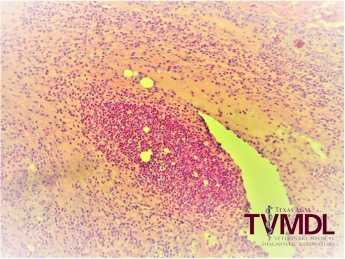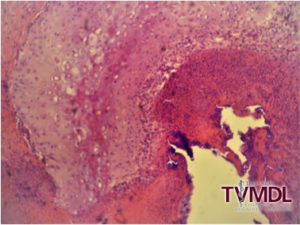Staphylococcosis and fowl pox in broiler breeders
By Gabriel Senties-Cue, MVZ, EPAA, MS
Staphylococcosis and fowl pox were diagnosed at the Texas A&M Veterinary Medical Diagnostic Laboratory (TVMDL) poultry lab in Center, TX, in a flock of 17-week-old, meat type, breeder, chickens. Three dead birds were submitted for laboratory examination. Grossly, all the birds had moderately swollen gastrocnemius tendons and hocks, as well as moderate to large numbers of black, raised nodules on the skin of the face, wattles, eyelids, and comb. Staphylococcus aureus was isolated in large numbers from hocks. The histological examination revealed severe mixed inflammation in the synovium of the affected tendons (see Fig. 1), and hyperplasia, hypertrophy (ballooning), and eosinophilic, intracytoplasmic inclusions in epithelial cells of the skin. Necrotic debris and large numbers of bacteria were seen associated with the skin lesions (see Fig. 2).
To learn more about this case, contact Center Resident Director Dr. Gabriel Senties-Cue. For more information about TVMDL’s test services, visit tvmdl.tamu.edu or call 1.888.646.5623.

